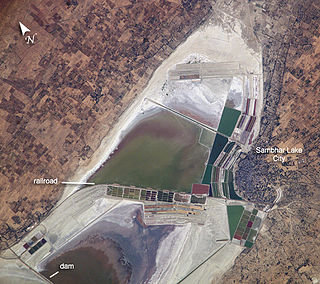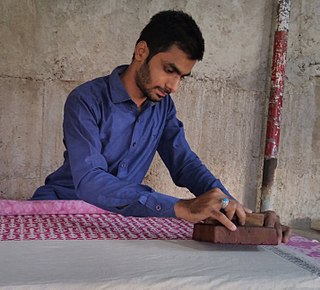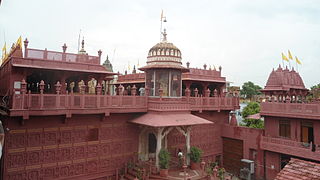Related Research Articles

Calico is a heavy plain-woven textile made from unbleached, and often not fully processed, cotton. It may also contain unseparated husk parts. The fabric is far coarser than muslin, but less coarse and thick than canvas or denim. However, it is still very cheap owing to its unfinished and undyed appearance.

A quilt is a multi-layered textile, traditionally composed of two or more layers of fabric or fiber. Commonly three layers are used with a filler material. These layers traditionally include a woven cloth top, a layer of batting or wadding, and a woven back combined using the techniques of quilting. This is the process of sewing on the face of the fabric, and not just the edges, to combine the three layers together to reinforce the material. Stitching patterns can be a decorative element. A single piece of fabric can be used for the top of a quilt, but in many cases the top is created from smaller fabric pieces joined, or patchwork. The pattern and color of these pieces creates the design.

Jaipur, formerly known as Jeypore, is the capital and the largest city of the Indian state of Rajasthan. As of 2011, the city has a population of 3.1 million, making it the tenth most populous city in the country. Located 268 km from the national capital New Delhi, Jaipur is also known as the Pink City due to the dominant color scheme of its buildings in old city.

The Sambhar Salt Lake, India's largest inland salt lake, is located in Sambhar Lake Town, Jaipur district of Rajasthan, India, 80 km (50 mi) southwest of the city of Jaipur and 64 km (40 mi) northeast of Ajmer, Rajasthan. It surrounds the historical Sambhar Lake Town.

Bhilwara is a city and administrative headquarters in Bhilwara district of the Mewar region of Rajasthan, India. It has been termed as 'Textile city'.

Bandhani is a type of tie-dye textile decorated by plucking the cloth with the fingernails into many tiny bindings that form a figurative design. The term bandhani is derived from the Sanskrit verbal root bandh. Today, most Bandhani making centers are situated in Gujarat, Rajasthan, Sindh, Punjab region and in Tamil Nadu where it is known as Sungudi. It is known as chunri in Pakistan. Earliest evidence of Bandhani dates back to Indus Valley civilization where dyeing was done as early as 4000 B.C. The earliest example of the most pervasive type of Bandhani dots can be seen in the 6th century paintings depicting the life of Buddha found on the wall of Cave at Ajanta. Bandhani is also known as Bandhej Saree, Bandhni, Piliya, and Chungidi in Tamil and regional dialects. Other tying techniques include Mothra, Ekdali and Shikari depending on the manner in which the cloth is tied. The final products are known with various names including Khombi, Ghar Chola, Patori and Chandrokhani.

Textile printing is the process of applying color to fabric in definite patterns or designs. In properly printed fabrics the colour is bonded with the fibre, so as to resist washing and friction. Textile printing is related to dyeing but in dyeing properly the whole fabric is uniformly covered with one colour, whereas in printing one or more colours are applied to it in certain parts only, and in sharply defined patterns.

Bagru is a town and a municipality in Jaipur district in the state of Rajasthan, India. It is located at a distance of 32 km from Jaipur, on Jaipur-Ajmer Road.

Ajrak, also known as Ajrakh, is a unique form of textile block-printing found primarily in Sindh, Pakistan and the village of Ajrakhpur in the bordering Kutch district of India. Ajrak textiles like shawls or dresses display special designs and patterns made using block printing with stamps. Ajrak is a symbol of Sindhi culture and traditions. Ajrak prints are also famous in neighbouring areas of India, in Gujarat, due to their influence from the Indus Valley civilization. Apart from Sindh and Kutch, recently, a Saraiki version of the Ajrak called Sajarak was created and is found in South Punjab, Pakistan.

Woodblock printing on textiles is the process of printing patterns on textile, usually of linen, cotton or silk, by means of carved wooden blocks.

Sanganer is a town/tehsil situated in Jaipur district, Rajasthan, 16 km south of state capital Jaipur. Jaipur has been divided in 13 Sub divisions and Sanganer is one of these 13 Sub divisions. It is famous for textile printing, handmade paper industry, and for Jain temples. Sanganer prints are one of its own kinds, for the reason that the patterns in bright colours are always printed on white backgrounds. Sanganeri Hand block printing received the geographical indication (GI) tag in 2010.

The culture of Rajasthan includes many artistic traditions that reflect the ancient Indian way of life. Rajasthan is also called the "Land of Kings". It has many tourist attractions and facilities for tourists. This historical state of India attracts tourists and vacationers with its rich culture, tradition, heritage and monuments. It also has some wildlife sanctuaries and national parks.

Sabyasachi Mukherjee is an Indian fashion designer, jewelry designer, retailer and couturier from Kolkata, India. Since 1999, he has sold designer merchandise using the label Sabyasachi. Mukherjee is one of the Associate Designer Members of Fashion Design Council of India and the youngest board member of the National Museum of Indian Cinema. He has designed costumes for Bollywood films such as Guzaarish, Baabul, Laaga Chunari Mein Daag, Raavan, and English Vinglish.

Kalamkari is a type of hand-painted cotton textile produced in the Indian state of Andhra Pradesh. Only natural dyes are used in Kalamkari, which involves twenty-three steps.
Bhankrota or Bang Rota is a residential locality within Jaipur, India. Started in the 1980s, it boomed in population in the late 1990s.

The crafts of India are diverse, rich in history, culture and religion. The craft of each state in India reflect the influence of different empires. Throughout centuries, crafts have been embedded as a culture and tradition within rural communities.

Bagh print is a traditional Indian handicraft originating in Bagh, Dhar district of Madhya Pradesh, India. The process is characterised by hand printed wood block relief prints with naturally sourced pigments and dyes. Bagh print motifs are typically geometric, paisley, or floral compositions design, dyed with vegetable colours of red and black over a white background, and is a popular textile printing product. Its name is derived from the village Bagh located on the banks of the Bagh River.
Anokhi is an Indian retailer based in Jaipur, Rajasthan, which retails textiles, clothing, furnishings, and accessories, made with traditional Indian motifs and techniques. It was founded in 1970 by husband and wife, John and Faith Singh, with a focus on reviving traditional Rajasthani hand-block or woodcut printing techniques, and the use of natural vegetable dyes. Anokhi works directly with Rajasthani craftspeople, and retails through its 25 stores in India and a few stockists in Europe and the United States.

The Anokhi Museum of Hand Printing is a private museum located in Amber, Rajasthan dedicated to the art of hand-block printing. Opened in 2005, the museum is an initiative of the founders of Anokhi, an Indian retail brand of block-printed clothes.
Block printing in India holds a significant place in the country's rich cultural heritage and artistic traditions. Dating back thousands of years, this ancient technique of textile decoration involves the meticulous carving of intricate designs onto wooden blocks, which are then dipped in natural dyes and stamped onto fabric to create vibrant patterns and motifs.
References
- ↑ Duttagupta, Ishani. "A prayer for the dyeing: Struggles of Chhipa community in Rajasthan". The Economic Times.
- ↑ Art Culture and Heritage of Rajasthan Study Material with MCQ: Useful for RPSC RAS Prelims and Other Exams. New Era Publication.
- ↑ Needleman, Deborah (18 May 2018). "The Ancient Art of Jaipur Block Printing, and What It Means to India". The New York Times.
- ↑ Murthy, Vaibhavi (10 July 2020). "All about Bagru Dabu Print Fabrics". CTC Jaipur. Archived from the original on 23 October 2020. Retrieved 20 October 2020.